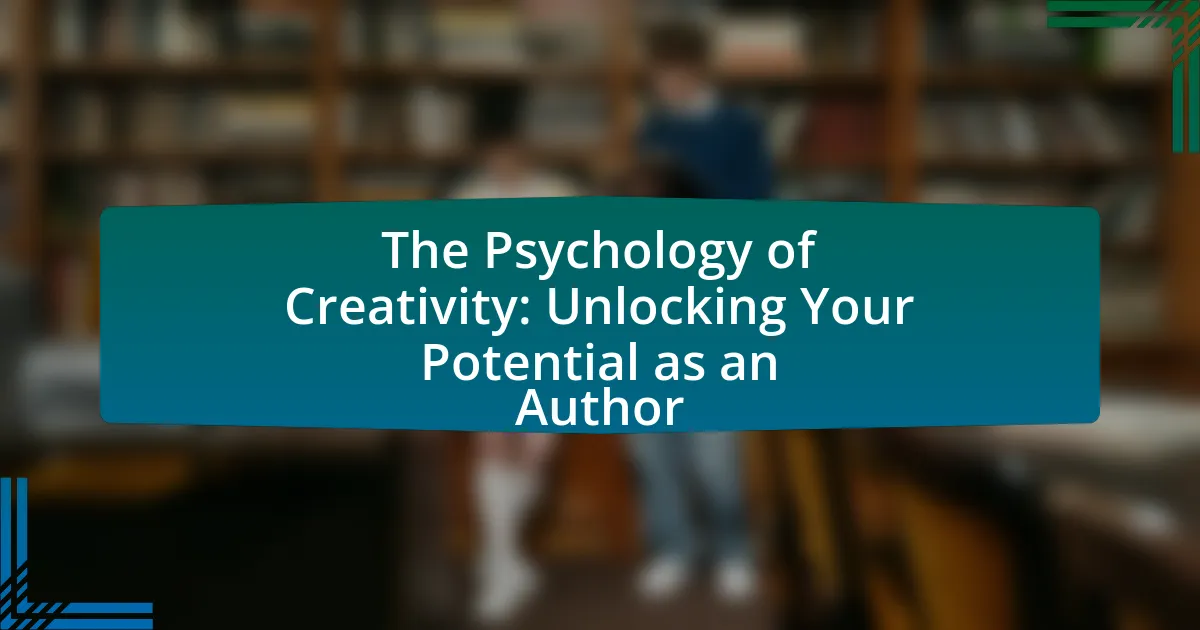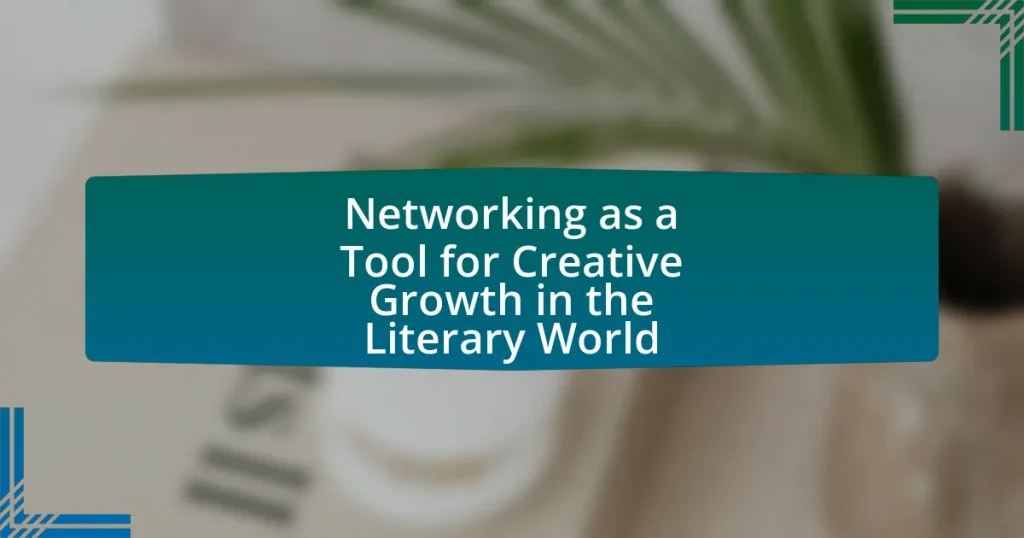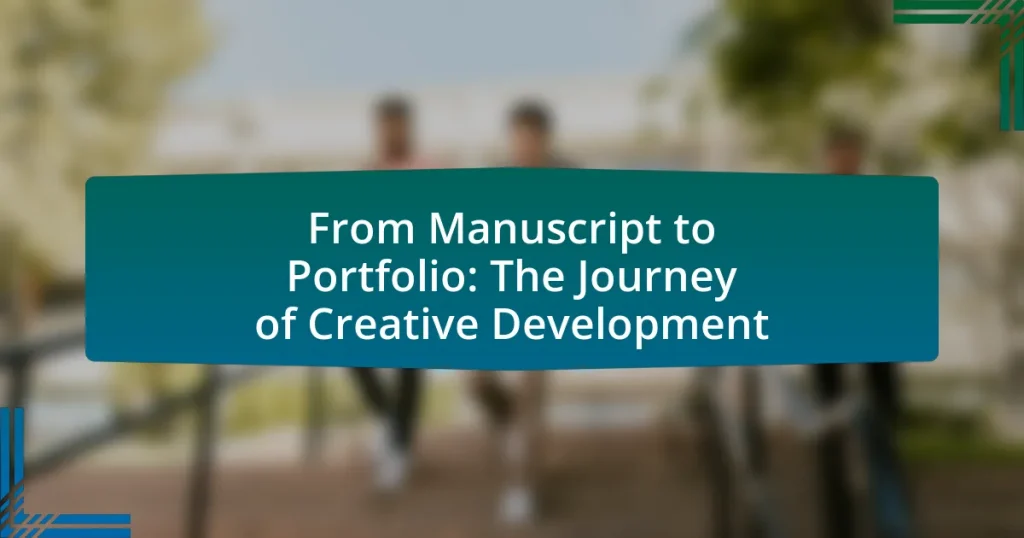The article explores the psychology of creativity, emphasizing the cognitive processes and emotional factors that contribute to generating novel ideas. It examines how individual differences, such as personality traits and cognitive styles, influence creative thinking, highlighting the importance of traits like openness to experience and intrinsic motivation. The article also discusses the role of the environment in fostering creativity, barriers authors face, and strategies to overcome these challenges. Additionally, it addresses how creativity enhances storytelling and character development, providing practical tips for authors to unlock their creative potential through structured routines, diverse experiences, and mindfulness practices.
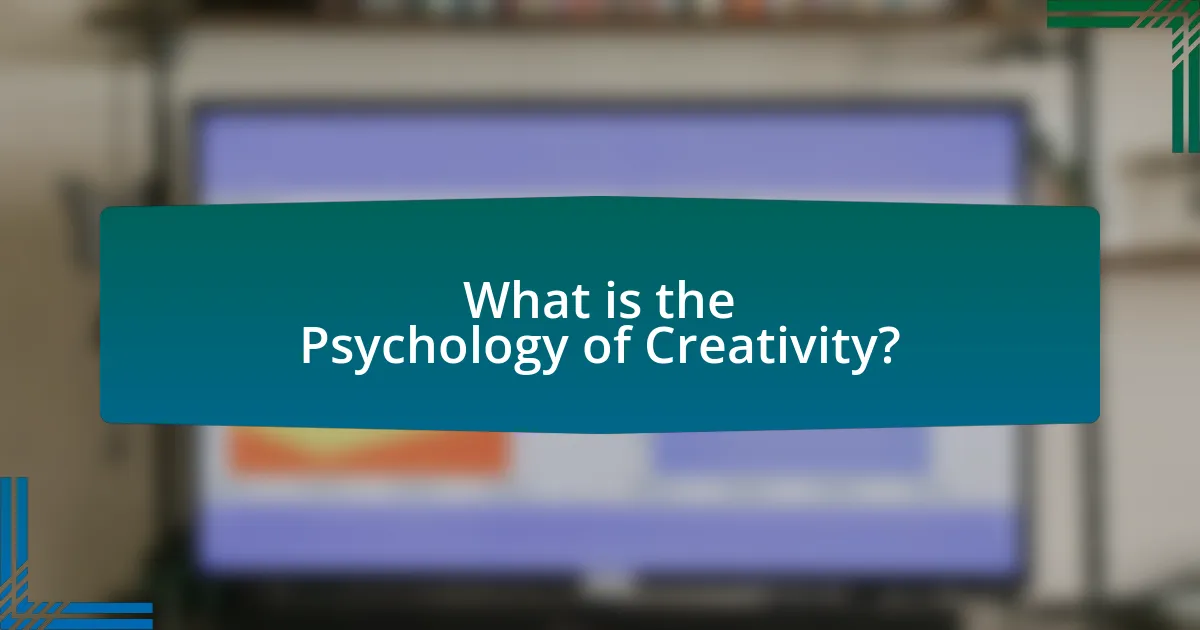
What is the Psychology of Creativity?
The psychology of creativity refers to the cognitive processes and emotional factors that contribute to the generation of novel and valuable ideas. This field examines how individual differences, such as personality traits and cognitive styles, influence creative thinking. Research indicates that traits like openness to experience and intrinsic motivation are positively correlated with creativity, as demonstrated in studies by Barron and Harrington (1981) and Runco (2004). Additionally, the environment plays a crucial role; supportive settings can enhance creative output, while restrictive environments may hinder it. Understanding these psychological components can help individuals unlock their creative potential, particularly in fields like writing and the arts.
How does creativity manifest in individuals?
Creativity manifests in individuals through unique expressions of thought, problem-solving abilities, and innovative ideas. This can be observed in various forms such as artistic endeavors, scientific discoveries, and everyday solutions to challenges. Research indicates that divergent thinking, which involves generating multiple solutions to a problem, is a key component of creativity. A study by Guilford (1950) highlighted that individuals who engage in divergent thinking tend to produce more original and varied ideas. Additionally, the ability to connect seemingly unrelated concepts, known as associative thinking, further exemplifies how creativity is expressed in individuals. This cognitive flexibility allows for novel combinations and insights, reinforcing the notion that creativity is not limited to traditional artistic fields but is a vital aspect of human cognition across disciplines.
What psychological factors influence creative thinking?
Psychological factors that influence creative thinking include cognitive flexibility, intrinsic motivation, and the ability to tolerate ambiguity. Cognitive flexibility allows individuals to adapt their thinking and approach problems from multiple perspectives, enhancing creativity. Intrinsic motivation drives individuals to engage in creative tasks for personal satisfaction rather than external rewards, which has been shown to foster innovative thinking. The ability to tolerate ambiguity enables individuals to navigate uncertainty and explore unconventional ideas, further promoting creative output. Research by Amabile (1996) in “Creativity in Context” supports these factors, demonstrating that environments fostering these psychological traits lead to higher levels of creativity.
How do personality traits affect creativity?
Personality traits significantly influence creativity by shaping how individuals think, approach problems, and express themselves. For instance, traits such as openness to experience are strongly correlated with creative thinking, as individuals high in this trait tend to embrace new ideas and experiences, fostering innovative thought processes. Research by McCrae and Costa (1997) in the Journal of Personality and Social Psychology indicates that openness is a key predictor of creative achievement across various domains. Additionally, traits like extraversion can enhance collaboration and idea sharing, further stimulating creative output. Conversely, high levels of neuroticism may hinder creativity by inducing anxiety and self-doubt, which can stifle innovative thinking. Thus, the interplay of personality traits directly affects an individual’s creative capabilities and expression.
Why is understanding creativity important for authors?
Understanding creativity is crucial for authors because it enables them to generate original ideas and develop unique narratives. Creativity allows authors to explore diverse perspectives, engage readers, and differentiate their work in a competitive market. Research indicates that creative thinking enhances problem-solving skills, which are essential for overcoming narrative challenges and character development. For instance, a study published in the Journal of Creative Behavior by Runco and Jaeger (2012) highlights that fostering creativity leads to increased innovation in writing, ultimately improving the quality and impact of literary works.
How can creativity enhance storytelling?
Creativity enhances storytelling by enabling authors to develop unique narratives and characters that resonate with audiences. This originality captivates readers, making stories more engaging and memorable. For instance, a study published in the Journal of Creative Behavior found that creative storytelling techniques, such as non-linear narratives and unexpected plot twists, significantly increase reader interest and emotional investment. By employing creativity, authors can also explore complex themes and emotions, allowing for deeper connections with their audience.
What role does creativity play in character development?
Creativity is essential in character development as it allows authors to construct complex, relatable, and dynamic characters that resonate with readers. Through creative processes, writers can explore diverse backgrounds, motivations, and emotional arcs, leading to richer narratives. For instance, a study by the University of California, Berkeley, highlights that creative thinking enhances empathy, enabling authors to better understand and portray their characters’ experiences and emotions. This depth in character development not only engages readers but also fosters a connection that can elevate the overall storytelling experience.

What are the barriers to creativity for authors?
Barriers to creativity for authors include fear of failure, lack of inspiration, and self-doubt. Fear of failure can paralyze authors, preventing them from taking risks in their writing, as evidenced by studies showing that anxiety can inhibit creative processes. Lack of inspiration often stems from external pressures, such as deadlines or market expectations, which can stifle originality. Self-doubt, frequently exacerbated by comparisons to other authors, can lead to a diminished sense of self-efficacy, further hindering creative expression. These factors collectively create an environment that is not conducive to the free flow of ideas necessary for creative writing.
How do fear and self-doubt impact creative expression?
Fear and self-doubt significantly hinder creative expression by creating mental barriers that inhibit the flow of ideas and self-confidence. When individuals experience fear, they often become paralyzed by the worry of judgment or failure, leading to avoidance of creative tasks. Self-doubt further exacerbates this issue, causing individuals to question their abilities and the value of their work. Research by Dr. Brené Brown highlights that vulnerability, which is often accompanied by fear and self-doubt, can stifle creativity, as individuals may refrain from taking risks necessary for innovative expression. This interplay of fear and self-doubt can result in decreased motivation and a reluctance to share creative work, ultimately limiting an individual’s potential as an author.
What strategies can authors use to overcome these barriers?
Authors can overcome barriers to creativity by implementing structured brainstorming techniques, setting specific writing goals, and establishing a consistent writing routine. Structured brainstorming, such as mind mapping, allows authors to visually organize their thoughts and generate new ideas, which can enhance creativity. Setting specific writing goals, such as daily word counts or chapter deadlines, provides authors with clear targets that can motivate them to write consistently. Establishing a consistent writing routine helps authors create a habit, reducing procrastination and increasing productivity. Research indicates that regular writing practice can significantly improve creative output, as demonstrated in studies on habit formation and creativity enhancement.
How does perfectionism hinder the creative process?
Perfectionism hinders the creative process by creating excessive self-criticism and fear of failure, which stifles innovation and experimentation. When individuals strive for unattainable standards, they often become paralyzed by the need for their work to be flawless, leading to procrastination and avoidance of creative tasks. Research by Dr. Brené Brown highlights that perfectionism is linked to feelings of shame and inadequacy, which can further inhibit creative expression. This cycle of self-doubt and fear can prevent individuals from taking risks necessary for creativity, ultimately limiting their potential to produce original and impactful work.
What environmental factors affect creativity?
Environmental factors that affect creativity include physical space, social interactions, and cultural influences. A conducive physical environment, such as one that is well-lit, organized, and aesthetically pleasing, can enhance creative thinking by reducing distractions and promoting comfort. Social interactions, particularly those that encourage collaboration and diverse perspectives, stimulate creativity by exposing individuals to new ideas and approaches. Cultural influences, including societal norms and values, shape the way creativity is expressed and perceived, impacting the willingness to take risks and innovate. Research by Amabile (1996) in “Creativity in Context” highlights that these environmental factors significantly influence creative performance, demonstrating the importance of context in fostering creativity.
How does the writing space influence creative output?
The writing space significantly influences creative output by affecting the writer’s mood, focus, and overall productivity. A well-organized and aesthetically pleasing environment can enhance creativity by reducing distractions and fostering a sense of comfort. Research indicates that environments with natural light and plants can improve cognitive function and creativity, as shown in a study published in the Journal of Environmental Psychology, which found that exposure to nature can enhance creative problem-solving abilities. Additionally, personalizing a writing space with meaningful objects can evoke positive emotions and stimulate creative thinking, reinforcing the connection between the physical environment and creative performance.
What role does social interaction play in fostering creativity?
Social interaction significantly enhances creativity by facilitating the exchange of diverse ideas and perspectives. Engaging with others allows individuals to brainstorm collaboratively, leading to innovative solutions that may not arise in isolation. Research indicates that social environments stimulate cognitive processes essential for creative thinking, such as idea generation and problem-solving. For instance, a study published in the journal “Creativity Research Journal” by Paul Paulus and Bernard Nijstad found that group brainstorming sessions often yield more creative outcomes than individual efforts due to the synergy created through interaction. This evidence underscores the importance of social interaction as a catalyst for creativity.
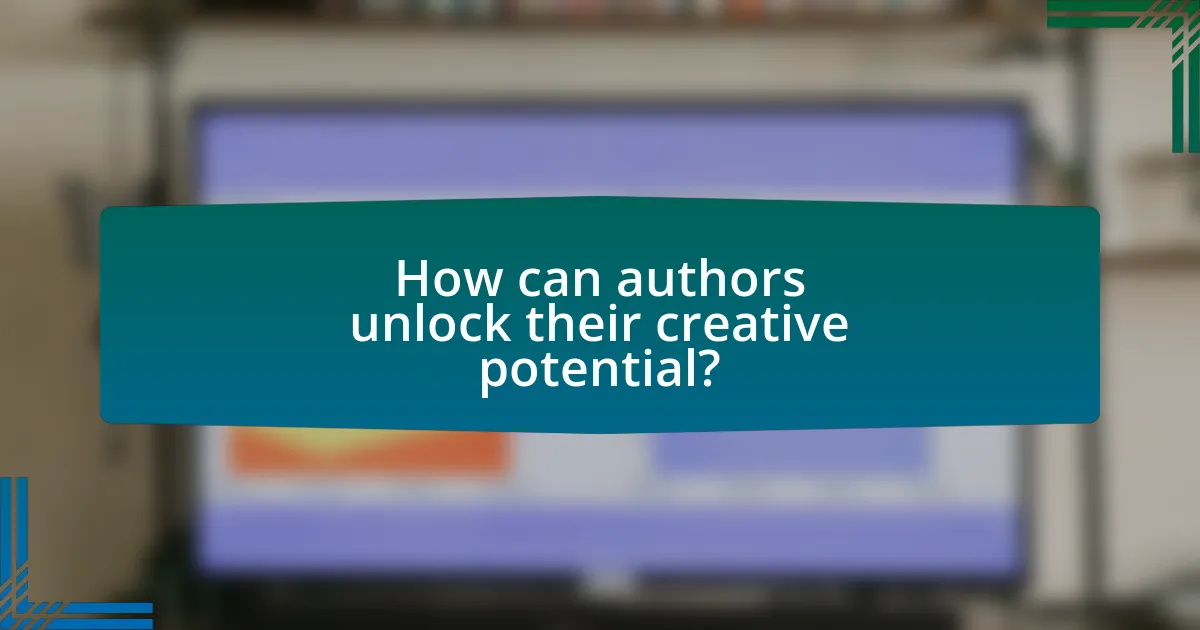
How can authors unlock their creative potential?
Authors can unlock their creative potential by engaging in regular writing practices, exploring diverse experiences, and embracing a growth mindset. Regular writing helps establish discipline and allows for the exploration of ideas without the pressure of perfection. Research indicates that creativity flourishes when individuals expose themselves to new experiences, as these experiences provide fresh perspectives and inspiration. Additionally, adopting a growth mindset, as outlined by psychologist Carol Dweck, encourages authors to view challenges as opportunities for development, thereby enhancing their creative output.
What techniques can enhance creative thinking?
Techniques that can enhance creative thinking include brainstorming, mind mapping, and engaging in divergent thinking. Brainstorming encourages the generation of a large number of ideas without immediate judgment, fostering an open environment for creativity. Mind mapping visually organizes thoughts and concepts, allowing individuals to see connections and relationships between ideas, which can lead to innovative solutions. Divergent thinking, which involves exploring multiple possible answers to a question, promotes flexibility and originality in thought processes. Research by Guilford (1950) emphasizes the importance of divergent thinking in creativity, demonstrating that individuals who practice these techniques often produce more original and varied ideas.
How can brainstorming sessions improve creativity?
Brainstorming sessions can improve creativity by fostering an open environment that encourages the free flow of ideas. This collaborative approach allows participants to build on each other’s thoughts, leading to innovative solutions that may not emerge in solitary thinking. Research indicates that group brainstorming can generate 20% more ideas than individual efforts, as demonstrated in a study published in the Journal of Creative Behavior, which highlights the effectiveness of collective idea generation in enhancing creative output.
What is the importance of routine in the creative process?
Routine is crucial in the creative process as it establishes a structured environment that fosters creativity. By adhering to a consistent schedule, individuals can create a mental space conducive to idea generation and exploration. Research indicates that routines help reduce decision fatigue, allowing creators to focus more on their work rather than on when or how to start. For instance, a study published in the journal “Psychological Science” by Baumeister et al. (2018) found that structured routines can enhance self-control and productivity, which are essential for creative endeavors. Thus, a well-defined routine not only supports the creative process but also enhances overall output and innovation.
What practices can authors adopt to maintain creativity?
Authors can maintain creativity by establishing a consistent writing routine, engaging in diverse experiences, and practicing mindfulness. A consistent writing routine helps authors develop discipline and fosters a creative habit, as research indicates that regular practice enhances creative output. Engaging in diverse experiences, such as reading various genres, traveling, or exploring new hobbies, stimulates new ideas and perspectives, which are essential for creativity. Mindfulness practices, such as meditation, have been shown to improve focus and reduce stress, allowing authors to tap into their creative potential more effectively.
How does reading widely contribute to creative growth?
Reading widely enhances creative growth by exposing individuals to diverse ideas, perspectives, and styles. This exposure stimulates the brain’s ability to make connections between seemingly unrelated concepts, fostering innovative thinking. Research indicates that engaging with a variety of genres and authors can lead to increased cognitive flexibility, which is crucial for creativity. For instance, a study published in the journal “Creativity Research Journal” by researchers Baer and Kaufman found that individuals who read broadly demonstrate higher levels of creative problem-solving skills compared to those with limited reading habits. Thus, the act of reading widely not only enriches knowledge but also actively contributes to the development of creative capabilities.
What role does journaling play in enhancing creativity?
Journaling significantly enhances creativity by providing a structured outlet for self-expression and reflection. This practice allows individuals to explore thoughts and ideas freely, fostering a deeper understanding of their creative processes. Research indicates that expressive writing, such as journaling, can lead to increased cognitive flexibility and problem-solving skills, which are essential components of creativity. A study published in the journal “Psychological Science” by researchers from the University of California found that participants who engaged in expressive writing demonstrated improved creative thinking compared to those who did not. Thus, journaling serves as a valuable tool for unlocking and nurturing creative potential.
What are some practical tips for authors to boost creativity?
Authors can boost creativity by engaging in diverse activities that stimulate the mind. For instance, practicing free writing for 10-15 minutes daily can help overcome mental blocks and generate new ideas. Research indicates that varied experiences enhance creative thinking; a study published in the Journal of Creative Behavior found that exposure to different environments and cultures significantly improves creative output. Additionally, incorporating regular breaks and physical exercise into a writing routine has been shown to enhance cognitive function and creativity, as physical activity increases blood flow to the brain.
